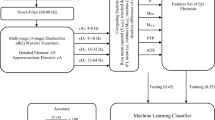Abstract
We designed a robot controller that can use unstable data, such as brain waves. The controller analyzes brain waves from a simple electroencephalograph. A user can concentrate to make the robot move faster, and relax to make it move slower. In order to judge the user’s state by his brain-wave data, we adopt a machine learning technique called support vector machine. We investigated improving the classification accuracy by increasing the number of data sets used to make the user concentration model. We increased the data sets from 30 to 180; consequently, the accuracy increased, with a maximum of about 80 % with 150 data sets. This indicates that our controller is able to accurately classify unstable data and can control a robot using brain waves from a simple electroencephalograph.






Similar content being viewed by others
References
Chang CC, Lin CJ (2011) LIBSVM: a library for support vector machines. ACM Trans Intell Syst Technol 2(3):1–27
Moran Daniel (2010) Evolution of brain–computer interface: action potentials, local field potentials and electrocorticograms. Curr Opin Neurobiol 20:741–745
Embedded Technology Software Design Robot Contest (in Japanese). http://www.etrobo.jp/
Tanaka K, Matsunaga K, Wang HO (2005) Electroencephalogram-based control of an electric wheelchair. Robot IEEE Trans 21(4):762–766
Fujiwara K, Hiraihsi H (2013) Action control and behavior selection based on reinforcement learning for a two-wheeled robot inverted (in Japanese). In: The 75th National Convention of IPSJ, vol 2, pp 219–220
Cristianini N, Shawe-Taylor J (2000) An introduction to support vector machines and other kernel-based learning methods. Cambridge University Press, Cambridge
NeuroSky, Inc. (2010) MindSet communications protocol
Schalk G, Leuthardt EC (2011) Brain-computer interfaces using electrocorticographic signals. Biomed Eng IEEE Rev 4:140–154
Ichikawa T (2006) An Invitation to journey for understanding of EEG. Seiwa Shoten Publishers, Tokyo (in Japanese)
Author information
Authors and Affiliations
Corresponding author
Additional information
This work was presented in part at the 20th International Symposium on Artificial Life and Robotics, Beppu, Oita, January 21–23, 2015.
About this article
Cite this article
Hiraishi, H. Designing a robot controller by using a simple brain-wave sensor and a machine learning technique. Artif Life Robotics 20, 217–221 (2015). https://doi.org/10.1007/s10015-015-0224-y
Received:
Accepted:
Published:
Issue Date:
DOI: https://doi.org/10.1007/s10015-015-0224-y




